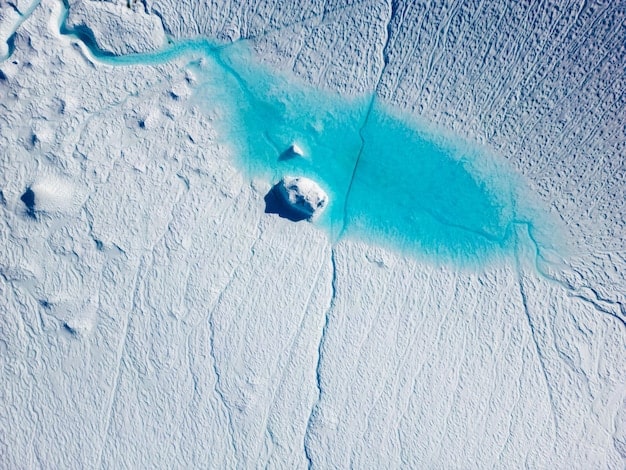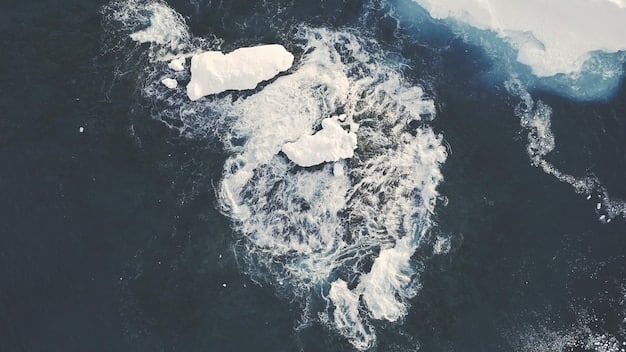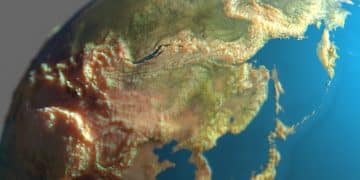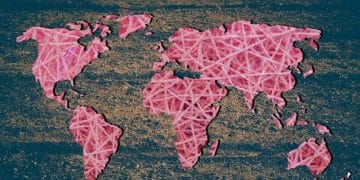US Arctic Strategy: Geopolitics & Environmental Changes

The United States faces complex geopolitical and environmental challenges in the Arctic, necessitating a strategic approach that balances national security, economic interests, and climate change mitigation amidst increasing global competition.
The Arctic, once a remote and largely forgotten frontier, is rapidly emerging as a critical region on the global stage. As ice melts and new maritime routes become accessible, the challenges facing The US and the Arctic: Navigating the Geopolitical and Environmental Challenges are multifaceted, encompassing national security, economic competition, and the undeniable impacts of climate change. This shifts the dynamic, demanding a comprehensive and adaptable strategy from Washington to safeguard its interests and maintain stability in this evolving geopolitical landscape.
The Shifting Arctic Landscape and US Interests
The Arctic is undergoing profound transformations, driven primarily by climate change. Diminishing sea ice opens new shipping routes, extracts previously inaccessible resources, and creates both opportunities and risks for the United States. Understanding these shifts is paramount to formulating effective policy, as the melting ice reshapes the physical environment and, consequently, the geopolitical dynamics of the region.
For the US, situated as an Arctic nation due to Alaska, the stakes are undeniably high. Its strategic priorities in the region are a complex interplay of defense, economic development, environmental protection, and scientific research. Each of these pillars demands careful consideration and integrated policy approaches to ensure long-term national benefit and regional stability.
Geographic and Strategic Importance of Alaska
Alaska serves as the United States’ primary gateway to the Arctic, providing significant strategic advantages. Its extensive coastline, proximity to key Arctic pathways, and rich natural resources make it an invaluable asset in the nation’s Arctic strategy. The state’s geographical position not only offers military outposts but also potential economic hubs for future Arctic trade and resource extraction.
- Strategic Defense: Alaska hosts critical military installations, essential for missile defense and surveillance capabilities, effectively serving as the nation’s northern flank.
- Resource Endowments: The state possesses significant oil, natural gas, and mineral reserves, which could play a role in future energy security but require careful environmental consideration.
- Indigenous Communities: Alaskan Native communities have deep historical ties to the land and a profound understanding of the Arctic environment, making their insights vital for sustainable development.
The melting Arctic presents Alaska with both opportunities for economic growth through new shipping lanes and resource access, and challenges such as coastal erosion, infrastructure damage, and impacts on traditional livelihoods. Balancing these factors is crucial for Alaska’s future and, by extension, the overall US Arctic posture.
Navigating these complexities requires the US to not only project power and protect its interests but also to engage collaboratively with other Arctic and non-Arctic nations. The unique environment of the Arctic dictates that no single nation can effectively address its challenges in isolation.
Geopolitical Stakes: Competition and Cooperation
The Arctic is fast becoming a new arena for great power competition, largely driven by its strategic location and potential resource wealth. While the US traditionally emphasizes cooperation under international law, other nations, particularly Russia and China, are demonstrating increasingly assertive postures. This shift necessitates a careful balancing act between upholding international norms and safeguarding national interests.
Russia, with the largest Arctic coastline, views the region as vital for its national security and economic prosperity. It has heavily invested in military infrastructure, icebreaker fleets, and commercial projects along its Northern Sea Route. This buildup presents a significant challenge to the US, requiring a proportionate and strategic response to maintain regional balance and deterrence.
The Expanding Role of China in the Arctic
Although not an Arctic nation, China has declared itself a “near-Arctic state” and is actively seeking to expand its influence through economic investments and scientific research. China’s “Polar Silk Road” initiative aims to integrate Arctic shipping routes into its Belt and Road Initiative, creating new trade corridors and access to resources.
- Economic Investments: China has invested in Arctic infrastructure, mining operations, and energy projects, particularly in Russia and Nordic countries.
- Scientific Diplomacy: Increased Chinese scientific expeditions and research stations in the Arctic serve to enhance its understanding of the region and legitimize its presence.
- Strategic Implications: While framed as economic and scientific, China’s growing presence raises concerns about dual-use capabilities and its long-term strategic intentions in the region.
The US approach to this competition emphasizes upholding freedom of navigation, promoting international law, and fostering transparency. While competition is undeniable, the US also recognizes the importance of maintaining channels for cooperation on issues like search and rescue, scientific research, and environmental protection, as these are common interests that transcend geopolitical rivalries.
The delicate balance between competition and cooperation underscores the complexity of Arctic diplomacy. The US seeks to prevent militarization of the Arctic while ensuring its capacity to operate effectively in the region and project its influence when necessary. This requires robust naval capabilities, including icebreakers, and strong alliances with other Arctic nations.
Environmental Challenges: Climate Change and Its Impact
The Arctic is warming at a rate two to three times faster than the global average, leading to profound environmental changes that impact not only the region itself but the entire planet. This rapid warming exacerbates existing environmental challenges and creates new ones, making climate change a central pillar of any comprehensive Arctic strategy for the United States.
The most visible manifestation of this warming is the dramatic retreat of sea ice, leading to an “ice-free” Arctic Ocean during summer months possibly within decades. This has direct implications for global weather patterns, sea levels, and biodiversity. The US must grapple with these scientific realities while formulating policies that address both mitigation and adaptation.

Permafrost Thaw and Infrastructure Risks
Beyond sea ice melt, the thawing of permafrost is another critical environmental concern. Permafrost, ground that has remained frozen for at least two consecutive years, covers vast areas of the Arctic. Its thaw releases potent greenhouse gases like methane and carbon dioxide, creating a dangerous feedback loop that accelerates global warming.
- Infrastructure Damage: Thawing permafrost destabilizes buildings, roads, pipelines, and other critical infrastructure built on frozen ground, requiring costly repairs and relocation.
- Ecological Shifts: Changes in vegetation patterns, increased wildfires, and altered wildlife habitats directly impact indigenous communities and local ecosystems.
- Disease Release: There is a potential, albeit rare, risk of ancient pathogens being released from long-frozen permafrost, posing new public health challenges.
The US acknowledges these environmental shifts pose direct threats to its Alaskan communities and infrastructure. Coastal erosion, for instance, forces entire villages to consider relocation, raising complex questions about funding, logistics, and cultural preservation. These challenges necessitate significant investment in Arctic research, climate resilience, and sustainable development practices.
While the environmental impacts are global, the Arctic serves as a critical natural laboratory for understanding climate change. US scientific efforts in the region contribute to global climate models and provide crucial data for adaptation strategies worldwide. This scientific leadership is a key component of the nation’s broader environmental diplomacy.
Economic Opportunities and Resource Management
The opening of new shipping routes and the potential extraction of vast natural resources create significant economic opportunities in the Arctic, but also present complex challenges related to environmental stewardship and sustainable development. The US approaches these opportunities with a focus on responsible development that balances economic gain with ecological protection.
The Northern Sea Route, along Russia’s coastline, and the Northwest Passage, through Canada’s Arctic archipelago, offer shorter transit times between Asia and Europe compared to traditional routes through the Suez or Panama Canals. While currently limited by ice, these routes hold long-term potential for commercial shipping, significantly reducing fuel consumption and travel time.
Fisheries, Tourism, and Shipping Lanes
Beyond fossil fuels, the Arctic boasts rich fishing grounds, expanding tourism potential, and new shipping opportunities. These sectors require careful management to ensure sustainability and minimize environmental impact.
- Sustainable Fisheries: The US advocates for science-based fisheries management to protect fish stocks and ensure the long-term viability of commercial and subsistence fishing.
- Responsible Tourism: Increased tourism brings economic benefits but also risks to fragile ecosystems and indigenous cultures, necessitating strict regulations and guidelines.
- Navigational Infrastructure: Developing safe and efficient shipping lanes requires significant investment in charting, search and rescue capabilities, and environmental response infrastructure.
The US strategy emphasizes the importance of international cooperation in managing these economic opportunities. The Arctic Council, though currently paused in some activities due to geopolitical tensions, remains a critical forum for discussing environmental protection, sustainable development, and indigenous affairs. Bilateral and multilateral agreements are vital for ensuring orderly resource management and preventing disputes.
The balance between economic exploitation and environmental preservation is a recurring dilemma in the Arctic. The US aims to lead by example, promoting best practices and advocating for high environmental standards in all commercial activities. This includes advocating for stricter regulations on pollution, oil spill prevention, and sustainable resource extraction techniques.
US Diplomatic and Security Posture
The United States’ diplomatic and security posture in the Arctic is designed to protect its national interests, uphold international law, and promote regional stability. This involves a multifaceted approach that combines military readiness, diplomatic engagement, and strong alliances to counter emerging threats and foster peaceful cooperation.
Central to the US security posture is the need for enhanced domain awareness and operational capabilities in a challenging environment. This includes investing in icebreaking capabilities, improving port infrastructure in Alaska, and enhancing capabilities for surveillance, search and rescue, and environmental response.
Strengthening Alliances and International Cooperation
The US recognizes that a strong network of alliances is crucial for effective Arctic governance and security. Working closely with fellow Arctic nations—Canada, Denmark (Greenland), Finland, Iceland, Norway, and Sweden—is paramount to ensure a unified approach to common challenges.
- NATO’s Role: As several Arctic nations are NATO members, the alliance provides a platform for defense cooperation and exercises aimed at enhancing interoperability in cold weather environments.
- Bilateral Engagements: Robust bilateral relationships with Canada, Norway, and other Nordic countries facilitate information sharing, joint exercises, and coordinated policy approaches.
- Rules-Based Order: The US strongly advocates for the continued application of existing international law, including the UN Convention on the Law of the Sea (UNCLOS), to resolve disputes and ensure freedom of navigation.
Diplomatically, the US seeks to maintain the Arctic as a region of low tension, promoting dialogue and conflict prevention. While geopolitical realities have strained mechanisms like the Arctic Council, the US continues to support forums where scientific cooperation and indigenous issues can be discussed. Future engagements will likely involve a pragmatic balance between managing competition and seeking areas for collaboration, particularly on safety and environmental concerns.
Ensuring a credible deterrent presence while avoiding escalation is a delicate act. The US military’s increased focus on Arctic training, modernization of forces, and development of specialized equipment reflects this strategic imperative. This holistic approach ensures the US is prepared for a range of contingencies, from humanitarian assistance to defense operations.
Indigenous Communities and Research Initiatives
Indigenous communities are integral to the Arctic’s past, present, and future. Their traditional knowledge, resilience, and unique cultural heritage must be central to any US Arctic policy. Simultaneously, robust scientific research initiatives are critical for understanding the rapidly changing environment and informing sustainable solutions.
For centuries, Alaskan Native peoples have thrived in the Arctic, developing profound insights into its ecosystems and sustainable living practices. Their deep connection to the land and dependence on its resources make them particularly vulnerable to climate change impacts, but also vital partners in finding adaptive solutions.
Protecting Indigenous Rights and Empowering Voices
The US commitment to Arctic policy explicitly includes respecting the rights, cultures, and livelihoods of indigenous communities. This requires meaningful consultation and inclusion in decision-making processes that affect their ancestral lands and traditional ways of life.
- Co-management of Resources: Many indigenous communities participate in co-management agreements for fish and wildlife, integrating traditional knowledge with scientific data.
- Climate Change Adaptation: Supporting community-led efforts to adapt to coastal erosion, thawing permafrost, and food security challenges is crucial.
- Cultural Preservation: Policies must ensure that economic development does not undermine the unique languages, traditions, and social structures of Arctic indigenous groups.
Beyond traditional knowledge, cutting-edge scientific research is essential for addressing Arctic challenges. The US invests in Arctic research across various disciplines, from oceanography and atmospheric science to social sciences and engineering. This research informs policy, develops new technologies, and contributes to global understanding of climate change.
From monitoring ice melt and permafrost thaw to studying wildlife migration patterns and ocean acidification, US-funded research provides critical data. International scientific collaboration is also a cornerstone, as Arctic phenomena transcend national borders. This blend of indigenous wisdom and scientific inquiry provides the most comprehensive foundation for a sustainable and equitable future in the Arctic.
Future Outlook and Prioritized Action Areas
The future of the Arctic will be defined by an ongoing interplay of environmental change, geopolitical shifts, and economic development. For the United States, a forward-looking strategy must anticipate these trends and prioritize actions that secure its interests while promoting a stable, sustainable, and rules-based Arctic. This future outlook demands proactive engagement rather than reactive measures, ensuring the US remains a formidable and responsible Arctic power.
Key among future considerations is the persistent challenge of climate change. While adaptation efforts are crucial, the long-term viability of the Arctic ecosystem and its communities hinges on global efforts to reduce greenhouse gas emissions. The US role in international climate diplomacy will heavily influence the rate of Arctic warming and its cascading effects.
Key Action Areas for US Foreign Policy in the Arctic
Defining clear, actionable priorities will be critical for the US in the coming decades. These priorities must encompass diplomatic, economic, environmental, and security dimensions, reflecting the integrated challenges of the region.
- Enhanced Arctic Awareness: Investing in surveillance, mapping, and scientific data collection to improve understanding of the changing environment and human activity.
- Infrastructure Investment: Modernizing and expanding Arctic infrastructure, including ports, icebreaker fleets, and communication networks, to support civilian and military operations.
- Strengthening Partnerships: Deepening collaboration with Arctic allies and partners to promote shared values, uphold international law, and coordinate crisis response.
- Promoting Sustainable Development: Advocating for and implementing environmentally sound economic practices that benefit local communities and protect fragile ecosystems.
The concept of “responsible stewardship” will likely guide US actions, balancing the imperative to protect national interests with a commitment to environmental sustainability and the well-being of Arctic populations. This means continuous engagement with indigenous communities, fostering scientific research, and advocating for robust international agreements.
Ultimately, the US strategy in the Arctic is a long-term endeavor, requiring consistent political will, strategic investments, and adaptive policies. By proactively addressing geopolitical competition, mitigating environmental impacts, and fostering inclusive economic development, the US aims to secure a peaceful and prosperous future for the Arctic region, a future that is increasingly critical for global stability and climate health.
| Key Point | Brief Description |
|---|---|
| ❄️ Climate Change | Rapid warming in the Arctic impacts sea ice, permafrost, and global weather patterns. |
| 🗺️ Geopolitical Competition | Increased competition from Russia and China for strategic access and resources. |
| 💰 Economic Opportunities | New shipping routes and resource extraction potential, balanced with environmental concerns. |
| 🤝 Diplomacy & Security | US focus on alliances, international law, and robust defense posture in the region. |
Frequently Asked Questions About the US and the Arctic
▼
The Arctic’s importance stems from accelerated climate change, which is melting ice and opening new maritime routes and access to resources. This environmental shift has profound geopolitical and economic implications, as nations compete for influence and assets in a previously inaccessible region, directly impacting U.S. national security and economic interests.
▼
The primary US interests in the Arctic include national security due to Alaska’s strategic location, economic opportunities from new shipping lanes and resource potential, environmental protection given the rapid pace of climate change, and the well-being and sovereign rights of indigenous communities residing there.
▼
Climate change is a fundamental driver of US Arctic strategy, as it directly impacts the physical environment (melting ice, thawing permafrost), creates new navigational and resource opportunities, and exacerbates risks to infrastructure and indigenous communities. The strategy must address both mitigation of and adaptation to these irreversible changes.
▼
The primary competitors to the US in the Arctic are Russia and China. Russia maintains a significant military and economic presence due to its vast Arctic coastline. China, while not an Arctic nation, is actively expanding its influence through economic investments and scientific initiatives, aiming for a “Polar Silk Road.”
▼
Indigenous communities play a crucial role in US Arctic policy. Their traditional knowledge is invaluable for understanding the environment, and their rights, cultures, and livelihoods are directly impacted by regional changes. US policy aims to ensure their meaningful consultation and active participation in decision-making processes impacting their homelands.
Conclusion
The United States stands at a crucial juncture regarding its role in the rapidly transforming Arctic. The intricate tapestry of climate change impacts, burgeoning geopolitical competition, and evolving economic opportunities necessitates a comprehensive, adaptable, and forward-thinking strategy. Balancing the imperatives of national security, economic prosperity, and environmental stewardship, while honoring the deep heritage of indigenous communities, will define its success. As the Arctic continues its dramatic transformation, the US commitment to international cooperation, adherence to the rules-based order, and strategic investments will be paramount in securing a stable, sustainable, and prosperous future for this pivotal region—a future that increasingly reverberates across the globe.





